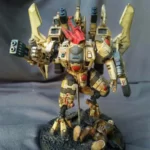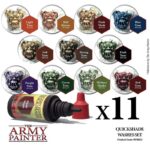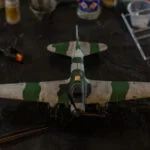Vallejo washes review
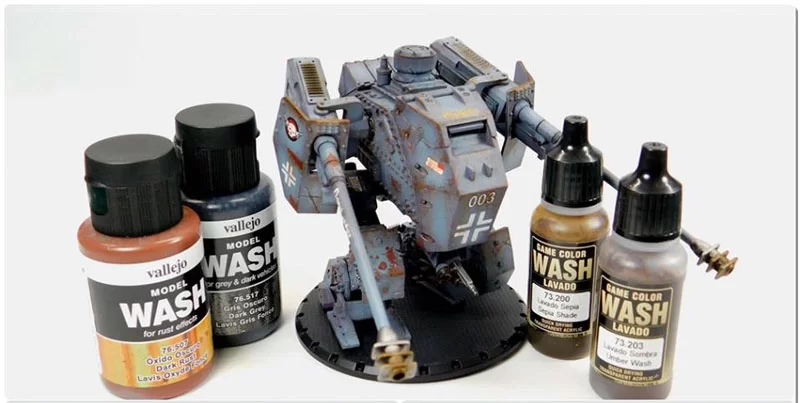
When it comes to giving your miniatures a more textured look, washes are a good paint to use. They help you create rust, snow, and mud, weathered or oily effects.
Many experienced painters recommend using Vallejo washes because they have a good amount of pigment that makes them superior to other washes.
Are Vallejo washes good?
Vallejo washes are a great choice for miniature painters, especially for those looking for weathering effects. The washes are formulated with water-based acrylic resin, making them safe for use on plastic or resin materials.
They have a good flow rate, are easy to use, and dry to a deeper, darker shade. Additionally, they are not overly thick, meaning they can easily settle into the recesses and raised details of a miniature.
However, they may need to be thinned for use on smaller models to ensure they reach every nook and cranny. Overall, Vallejo washes are a versatile and reliable choice for miniature painting.
What is wash paint?
Washes are fine paints, usually diluted. So, they appear very watery and won’t apply like regular miniature paints.
Wash paints often have low viscosity pigmented color and body so that when you apply them on your model, they flow easily into the cracks, deep recesses, and crevices of your figure to help cover hard-to-reach places.
Of course, with your regular paints, you can easily shift the color scheme of your model by mixing two colors. But washes do not work the same. Instead, their lightly thinned form means you can get dark tones, shift color, or even highlight parts of your model effortlessly.
Washes are especially useful in speed painting and help you maintain high contrast on a model.
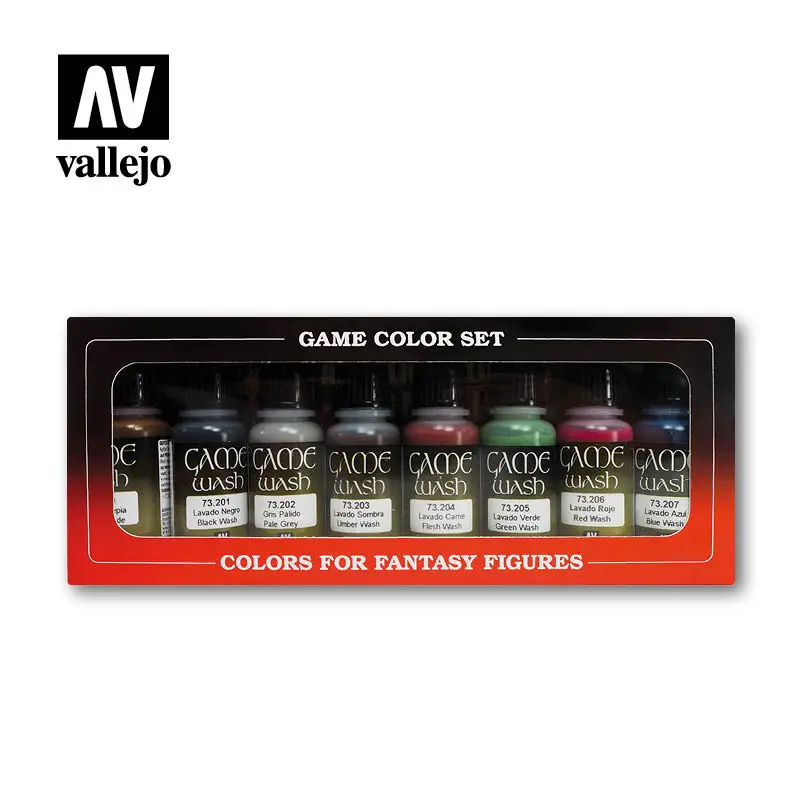

How does Vallejo washes work for miniatures and models?
Vallejo washes can create weathering effects on your armor, vehicles, planes, ship, figures, war game figures, and dioramas.
Beginner painters are definitely wondering why they need to create a weathered texture on their model when they can get other results that make their model look display-worthy. The simple answer is to make your model look as real as possible.
Wargaming figures, dioramas, ships, vehicles, and armor are designed after real-life replicas. So, since these figures are often used in intense environments, they will often spot a faded look thanks to sunrays, look dirty due to wind, dust, rain, and snow or experience a color change.
Replicating these changes to the figures makes the model appear realistic. Still, there’s a catch! You can’t achieve this with normal paint. Vallejo washes help you achieve these effects.
The washes often appear liquid and transparent, but they can perfectly blend into your models, from giving you a perfect camouflage color to achieving a wide range of effects like flaked rust, mud, oil, dust, earth, and moss. They can also help you create an appearance of heavy wear on your figures.
Is it water, oil, or alcohol-based?
Vallejo paints, from their base to the layer colors, are naturally acrylic, water-based paints. Their washes also retain this feature. Hence, Vallejo washes are water-based.
Is Vallejo wash good for miniatures and models?
Miniatures and scale models are often designed with plastic or resin materials. So, you want something that can keep them looking their best at all times without compromising their material.
Vallejo model and game color washes are formulated with acrylic resin so they can easily blend well with acrylic-based paints and the resin or plastic materials of the figure. Hence, they are perfect for miniatures are scale models.
Most washes are oil and solvent-based, with their advantage being that they have superficial tension that makes them adhere strongly to the model, so the paint lasts long.
The biggest drawback of solvent-based washes is that they can brittle the plastic and resin materials of your miniatures and scale models. On the other hand, oil washes take a long time to dry, making the process time-tasking.
Vallejo washes breakdown
- How does it flow?
I have been a fan of the Vallejo paints for a long while, and their washes are one of my favorites.
They have a good flow rate, although not as exceptional as solvent-based washes. They will easily settle into the recesses and raised details in minutes with a brush.
Then again, you want to apply them well since they will pool with the wrong application.
- Is it easy to use?
They are quite an easy nut to crack. In fact, you find painting them over your figures fun since their water-based form means they won’t cause any problem with your plastic or resin materials as solvent-based washes will.
- Should you thin it?
Vallejo washes are already thin and won’t have the viscosity of regular miniature paints. So, they don’t necessarily require thinning. But, there’s something you don’t know. Their thin form out of the bottle works better on a larger surface.
In other words, you need to pay more attention to how you apply it over smaller models.
You may need to dilute these washes with water and apply them in thinner layers, especially if you are using the colors on smaller models. This way, they can even get into small nooks and cracks.
- How do they dry?
Vallejo washes dry in much deeper, darker shades than most washes like the Citadel shades. Plus, depending on how you apply them, they can dry smooth or leave a slightly mottled look.
They also tend to dry hazy. Just apply them in thin layers and wait between 15 to 20 minutes for them to dry well. This way, you will get the actual results you hoped for.
- Should you airbrush?
Solvent-based washes should not be airbrushed, but that does not mean you can’t airbrush water-based acrylics. All Vallejo washes work well with an airbrush since they are water-based and not toxic. You don’t even need to thin them before spraying.
- How are the results
The downside of Vallejo washes is that they are often unpredictable when they dry. Vallejo weathering washes often leave chalky finishes. While the rest of their range can also dry glossy.
- Is it easy to clean
Their water-based formula means they are super-easy to clean. You only need water, a clean rag, and a few trials to clean it up nicely.
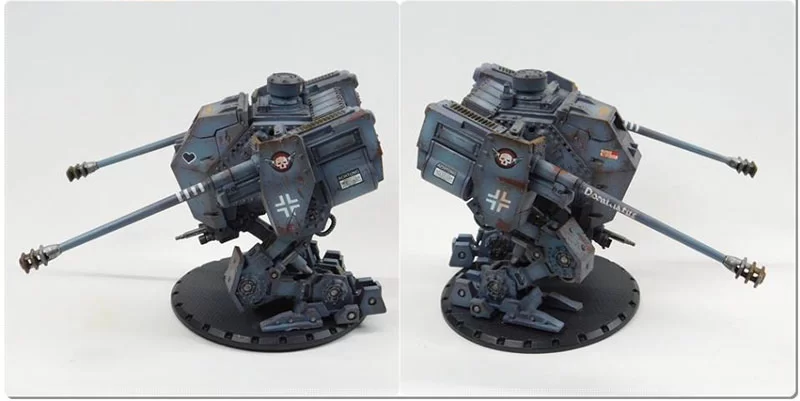

Vallejo has a wide range of wash colors
Vallejo washes have an interesting range of colors from their game color and model color range. Out of these colors, Dark Brown Wash works great, especially for vehicles and larger models.
It provides a way to add darkness to recesses without going black. It’s a subtle method, but effective for adding more contrast.
- 73.200 Black Shade
- 73.201 Sepia Shade
- 73.202 Pale Wash
- 73.203 Umber
- 73.204 Fleshtone
- 73.205 green
- 73.206 Red
- 73.207 Blue
On the other hand, the model wash colors include:
- 76.501 White
- 76.503 Dark Yellow
- 76.505 Light Rust
- 76.506 Rust
- 76.507 Dark Rust
- 76.512 Dark Green
- 76.513 Brown
- 76.514 Dark Brown
- 76.515 Light Grey
- 76.516 Off-Grey
- 76.517 Dark Grey
- 76.518 Black
- 76.519 Olive green
- 76.520 Dark Khaki Green
- 76.521 Oiled Earth
- 76.522 Desert Dust
- 76.523 European Dust
- 76.524 Blue Grey
tips for using Vallejo wash for best results
The best way to apply Vallejo wash is to do this:
- Load the brush with a lot of wash but not so much that it drips. It should just be enough to cover the surface.
- Drag the brush across the miniature’s surface instead of dabbing it. It allows you to apply most of the wash on the brush into the recesses of the model, especially between clothing folds.
- Avoid pulling the brush along the model, as you will end up cleaning the wash out of the recesses.
- Make sure the wash doesn’t pool too much. The wash tends to shrink as it dries. So, too much wash in a small area will cause a stained dark edge.
- As with regular miniature paint, apply washes in layers, especially if you aim to build pigments.
Vallejo wash set
Vallejo has an awesome 8-colored wash paint set, each in 17ml dropper bottles. This set costs only $19.42 but includes many colors, including Sepia, black, pale grey, umber, flesh, green, red and blue tones.
Do you really need a wash for your miniature?
If you are painting your miniatures and want to give them a more realistic look, then you really do need washes.
It improves the overall quality of your models, adds more depth and texture to them, and ensures they have similar details as the real thing.
However, they are not a mandatory color you should have in your collection.
Conclusion
The most common issues with acrylic-based washes are they tend to have less surface tension, leave tide marks, and won’t flow well. Vallejo washes are different, won’t leave brush marks, dry and flows well, work with an airbrush and look great on your model.
Their dark brown wash works like the favored Agrax Earrthshade from Citadel, and the black washes are possibly the best alternative for Citadel’s Nuln Oil.

